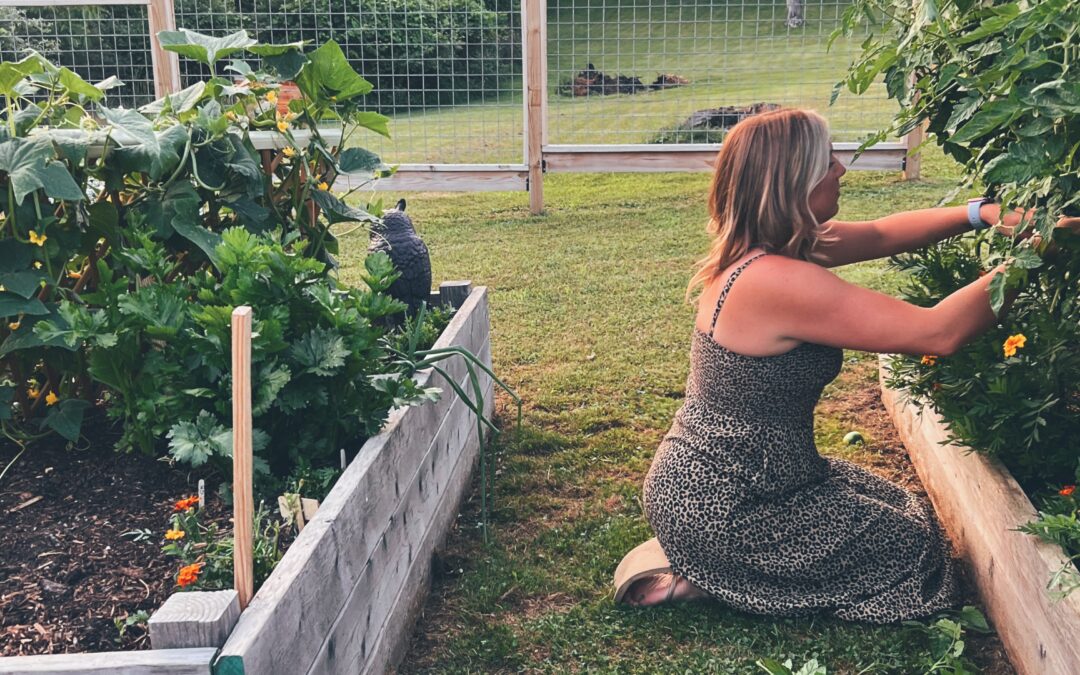Starting a garden can feel overwhelming, but with a little planning, you can create a thriving space that provides fresh produce for your family. Whether you’re looking to grow vegetables for the first time or simply want to streamline the process, I hope this beginner-friendly guide will help you get started.
When we moved to our home five years ago, we saw the amazing possibility to finally start a garden. The open space and abundance of sunlight made it clear that this was an opportunity we couldn’t pass up. We had always dreamed of growing our own food, but in our previous home, we lacked the space and the right conditions. Now, with the ability to design our garden from the ground up, we felt both excited and a little overwhelmed. We started by researching the best layout, considering what plants would thrive in our zone, and making a plan to ensure our garden would be productive yet manageable. That first season was full of trial and error, but it was incredibly rewarding to see our hard work turn into fresh vegetables on our dinner table.
Decide on Raised Beds or Tilling the Ground
One of the first decisions you’ll need to make is whether to use raised beds or till the ground. Raised beds offer several benefits, including better drainage, easier weed control, and improved soil quality. They also make gardening more manageable, especially for beginners. When we moved, we quickly realized that our soil wasn’t ideal for growing—full of clay and poor drainage—so we opted for raised beds. This allowed us to control the soil quality and create the best growing conditions for our plants. On the other hand, tilling the ground can be more cost-effective and allows for larger planting areas. Consider your space, budget, and physical ability before making a decision.
Start Small
It’s easy to get excited and plant more than you can handle, but starting small will set you up for success. A great beginner setup includes four 4×8 raised beds, which provide ample space for a variety of vegetables while remaining manageable. When we started, we used only these four beds, focusing on a few key crops to build our confidence. Each year, as we gained more experience and learned what worked best for our space, we added more square footage to expand our growing area. This gradual approach allowed us to scale up at a pace we could handle without feeling overwhelmed. If you’re planting directly in the ground, mark off a similar-sized area to keep things under control.
Choose a Good Location
Your garden’s success depends heavily on where you place it. Most vegetables need at least six to eight hours of direct sunlight per day. Pick a spot that gets plenty of sun, has well-draining soil, and is easily accessible for watering and maintenance. Avoid areas near large trees or buildings that may cast too much shade.
Know Your Zone
Understanding your USDA growing zone is crucial when selecting plants. Your zone determines the types of vegetables that will thrive and the best times to plant them. You can find your specific zone by visiting the USDA Plant Hardiness Zone Map at https://planthardiness.ars.usda.gov/home. Simply enter your ZIP code or navigate the interactive map to discover your zone, which will inform your plant choices and planting schedule.
Choose What You Want to Plant
It’s tempting to plant everything, but the best approach is to grow what you’ll actually use in the kitchen. Focus on staple vegetables your family enjoys, like tomatoes, peppers, lettuce, carrots, and herbs. This ensures you make the most of your garden space and avoid waste.
Start from Seeds or Buy Established Plants
Deciding whether to start from seeds or buy established plants depends on your time, budget, and experience level. Starting from seeds is more cost-effective and offers a wider variety of plant options, but it requires more patience and care in the early stages. Buying established plants is a great shortcut for beginners, ensuring quicker growth and a higher success rate. Consider a mix of both—start easy-to-grow crops like lettuce and radishes from seed while purchasing transplants for tomatoes and peppers. We personally love using seeds from RareSeeds.com because of their incredible heirloom selection, which allows us to grow unique, high-quality varieties that aren’t always available in local stores.
Protect Your Garden from Animals
Depending on where you live, deer, rabbits, and other critters may see your garden as a free buffet. If you’re in an area with a lot of wildlife, consider putting up a protective barrier such as fencing or netting. Even simple solutions like chicken wire or raised beds with covers can help keep pests out. When we first started, we used 8-foot stakes and deer fencing for the first two years to protect our crops. This temporary setup worked well until we were able to build a permanent fence around our garden. Taking steps early to safeguard your garden will save you time and frustration down the road.
Gardening is a rewarding experience that provides fresh, homegrown food while helping you connect with nature. By starting small, choosing the right location, and protecting your plants, you’ll set yourself up for success. With time and practice, you’ll develop the skills to expand and refine your garden to fit your family’s needs. Happy gardening!
